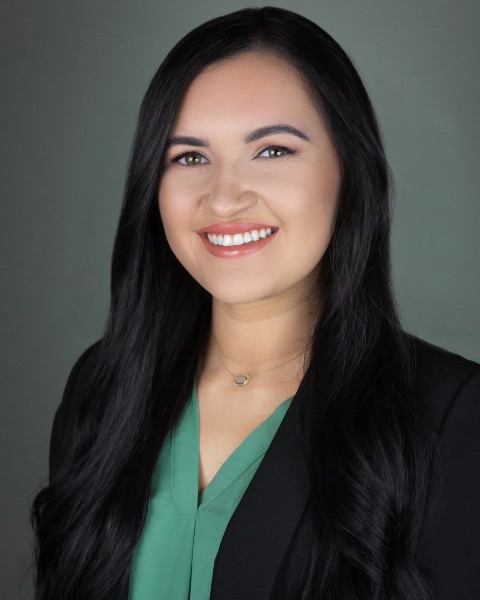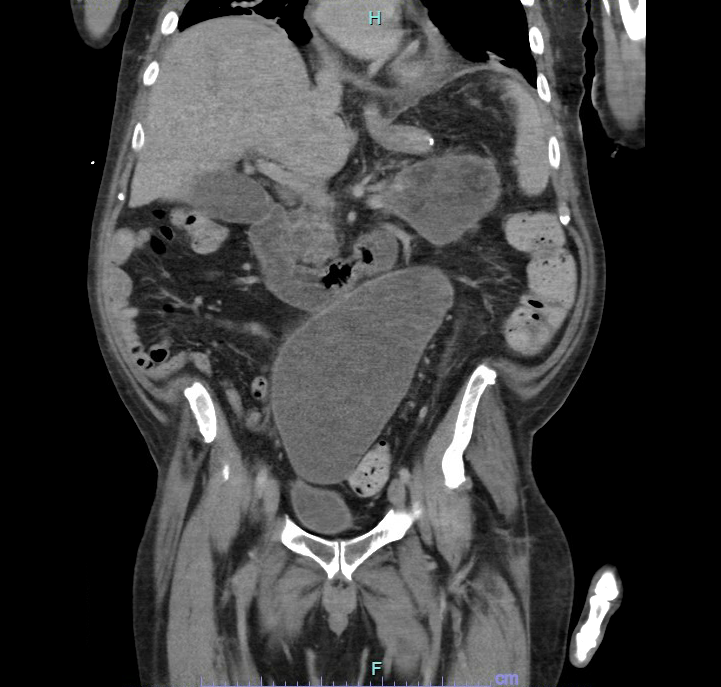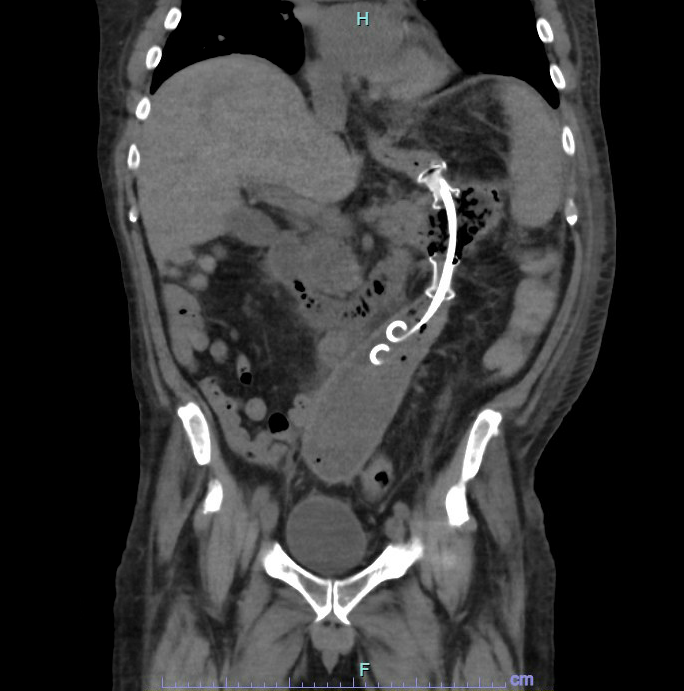Tuesday Poster Session
Category: Interventional Endoscopy
P5701 - Transgastric Cyst-Cystostomy for Management of a Remote Pelvic Fluid Collection: First Report of a Novel Endoscopic Approach
Tuesday, October 28, 2025
10:30 AM - 4:00 PM PDT
Location: Exhibit Hall

Kylie Dunn, DO
The University of Texas Health Science Center at Tyler
Tyler, TX
Presenting Author(s)
Award: ACG Presidential Poster Award
Kylie Dunn, DO1, John Martino, DO1, Muhammad Baig, MD2
1The University of Texas Health Science Center at Tyler, Tyler, TX; 2Methodist Dallas Medical Center, Dallas, TX
Introduction: Endoscopic ultrasound guided transluminal drainage has become the standard of care for managing pancreatic fluid collections and walled-off necrosis. However, drainage of distant, complex, or multiloculated collections remains technically challenging and has traditionally required surgical intervention or percutaneous drainage. We present a novel case of sequential lumen-apposing metal stent (LAMS) placement to access a distant pancreatic fluid collection. To our knowledge, this layered approach has not been previously described.
Case Description/
Methods: A 57-year-old male patient with a history of sleeve gastrectomy and recent alcohol-induced necrotizing pancreatitis was admitted to our facility with symptomatic and enlarging peri-pancreatic fluid collections. Cross-sectional imaging revealed a large 6 by 6.5 by 7.4 cm walled off necrotic collection with mass effect on the gastric body and an adjacent 5.8 by 6.4 by 14.9 cm separate, well-formed pelvic fluid collection. Endoscopic ultrasound-guided cyst gastrostomy was performed using a 20 mm x 10 mm LAMS to drain the peri-gastric pancreatic collection. After one week, an echoendoscope was passed into the peri-gastric collection and a cyst-cystostomy using 15 mm x 15 mm LAMS was performed to drain the pelvic fluid collection. The patient underwent a few endoscopic necrosectomies and was noted to have significant clinical and radiological improvement. He was ultimately discharged to a rehabilitation facility in stable clinical condition.
Discussion: This case highlights an innovative endoscopic strategy for managing complex, multiloculated pancreatic and pelvic fluid collections. By utilizing sequential LAMS—first establishing a cyst gastrostomy from the stomach to a pancreatic collection, then creating a cyst-cystostomy to a remote pelvic abscess—this approach provided minimally invasive access to otherwise surgically challenging locations. The successful use of this novel technique suggests a potential role for layered endoscopic drainage in the management of refractory fluid collections and highlights the expanding capabilities of interventional endoscopy in the treatment of complicated necrotizing pancreatitis.

Figure: Computed tomography scan on presentation showing large peri-gastric and pelvic fluid collections.

Figure: Computed tomography scan after cyst-gastrostomy and cyst-cystostomy.
Disclosures:
Kylie Dunn indicated no relevant financial relationships.
John Martino indicated no relevant financial relationships.
Muhammad Baig indicated no relevant financial relationships.
Kylie Dunn, DO1, John Martino, DO1, Muhammad Baig, MD2. P5701 - Transgastric Cyst-Cystostomy for Management of a Remote Pelvic Fluid Collection: First Report of a Novel Endoscopic Approach, ACG 2025 Annual Scientific Meeting Abstracts. Phoenix, AZ: American College of Gastroenterology.
Kylie Dunn, DO1, John Martino, DO1, Muhammad Baig, MD2
1The University of Texas Health Science Center at Tyler, Tyler, TX; 2Methodist Dallas Medical Center, Dallas, TX
Introduction: Endoscopic ultrasound guided transluminal drainage has become the standard of care for managing pancreatic fluid collections and walled-off necrosis. However, drainage of distant, complex, or multiloculated collections remains technically challenging and has traditionally required surgical intervention or percutaneous drainage. We present a novel case of sequential lumen-apposing metal stent (LAMS) placement to access a distant pancreatic fluid collection. To our knowledge, this layered approach has not been previously described.
Case Description/
Methods: A 57-year-old male patient with a history of sleeve gastrectomy and recent alcohol-induced necrotizing pancreatitis was admitted to our facility with symptomatic and enlarging peri-pancreatic fluid collections. Cross-sectional imaging revealed a large 6 by 6.5 by 7.4 cm walled off necrotic collection with mass effect on the gastric body and an adjacent 5.8 by 6.4 by 14.9 cm separate, well-formed pelvic fluid collection. Endoscopic ultrasound-guided cyst gastrostomy was performed using a 20 mm x 10 mm LAMS to drain the peri-gastric pancreatic collection. After one week, an echoendoscope was passed into the peri-gastric collection and a cyst-cystostomy using 15 mm x 15 mm LAMS was performed to drain the pelvic fluid collection. The patient underwent a few endoscopic necrosectomies and was noted to have significant clinical and radiological improvement. He was ultimately discharged to a rehabilitation facility in stable clinical condition.
Discussion: This case highlights an innovative endoscopic strategy for managing complex, multiloculated pancreatic and pelvic fluid collections. By utilizing sequential LAMS—first establishing a cyst gastrostomy from the stomach to a pancreatic collection, then creating a cyst-cystostomy to a remote pelvic abscess—this approach provided minimally invasive access to otherwise surgically challenging locations. The successful use of this novel technique suggests a potential role for layered endoscopic drainage in the management of refractory fluid collections and highlights the expanding capabilities of interventional endoscopy in the treatment of complicated necrotizing pancreatitis.

Figure: Computed tomography scan on presentation showing large peri-gastric and pelvic fluid collections.

Figure: Computed tomography scan after cyst-gastrostomy and cyst-cystostomy.
Disclosures:
Kylie Dunn indicated no relevant financial relationships.
John Martino indicated no relevant financial relationships.
Muhammad Baig indicated no relevant financial relationships.
Kylie Dunn, DO1, John Martino, DO1, Muhammad Baig, MD2. P5701 - Transgastric Cyst-Cystostomy for Management of a Remote Pelvic Fluid Collection: First Report of a Novel Endoscopic Approach, ACG 2025 Annual Scientific Meeting Abstracts. Phoenix, AZ: American College of Gastroenterology.

